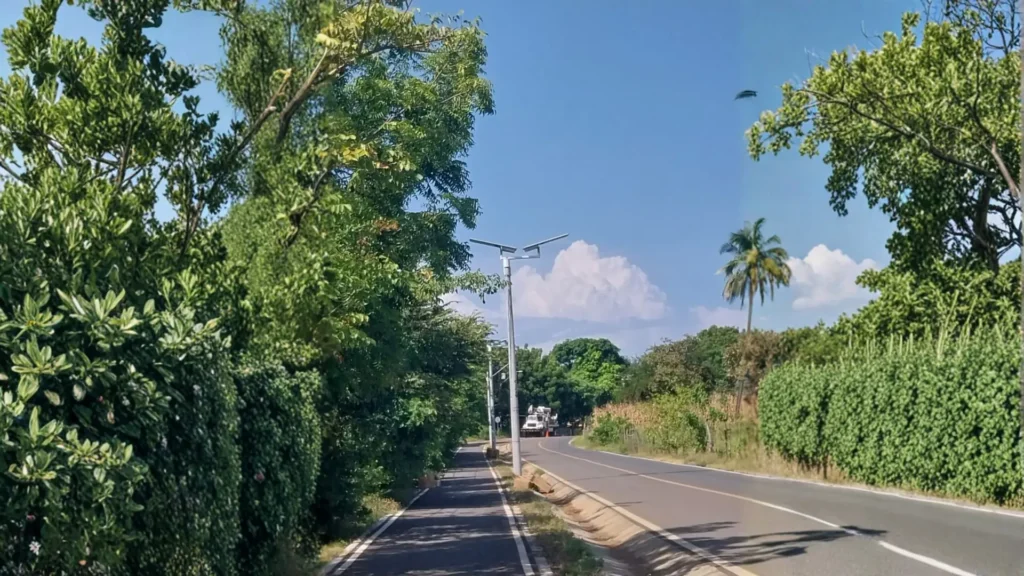Abstract
In Panama, an international logistics hub connecting the Americas’ two oceans, roads at the urban-rural fringe serve not only as economic lifelines but also as critical pathways for residents’ safe travel. However, a longstanding “lighting gap” has led to frequent nighttime accidents and hindered economic circulation. This project addresses these challenges by deploying Sresky Atlas integrated solar street lights, delivering reliable, zero-carbon illumination solutions.
I. Project Background and Needs Analysis
1.1 National Development and Geographical Context
As a strategic gateway in Central America, Panama’s road network underpins global trade, handling over 50 million tons of cargo annually. Roads connecting urban-rural fringe areas link urban centers like Panama City with vast rural hinterlands, serving as vital arteries for agricultural transport and population mobility. Yet these road infrastructures face severe challenges: low basic service coverage in rural areas, while urban expansion exacerbates traffic congestion and maintenance pressures. According to a 2025 report, Panama plans to invest $775 million to improve road connectivity between urban and rural areas, aiming to reduce commuting times and stimulate suburban economic growth.
Climate-wise, Panama features a tropical maritime climate with average annual temperatures above 28°C. The dry season (December-April) offers abundant sunshine, while the rainy season (May-November) brings precipitation exceeding 3,000 mm, with continuous rainfall lasting for weeks. Rainy season cloud cover reduces solar panel efficiency by 10-30%, though rainfall cleans panel surfaces, enhancing long-term output.
Project Scenario
Focus on typical urban-rural road segments: As illustrated, roads traverse dense vegetation while handling freight trucks and daily commuters, with nighttime darkness amplifying risks. The Sresky Atlas series adapts to this environment using ALS2.3 technology, ensuring sustained performance during the rainy season.
1.2 Core Needs and the “Lighting Gap”
High accident rates plague urban-rural fringe roads: Panama recorded 591 traffic fatalities in 2020, with a mortality rate of 13.99 per 100,000 population. Rural areas account for a significant proportion of these deaths due to inadequate lighting and complex road conditions. The nighttime mixing of pedestrians and vehicles increases collision risks, threatening lives and property. Economically, insufficient lighting hampers logistics efficiency. Delays in nighttime agricultural transport cause losses reaching hundreds of millions of dollars, stifling rural development and creating an urban-rural “lighting divide.”
Limited Grid Coverage: Power supply remains unstable in urban-rural transition zones, with traditional streetlights costing over $100,000/km annually in electricity fees. Panama’s National Energy Plan (2015-2050) emphasizes energy transition, targeting 70% renewable energy by 2050, requiring zero-carbon infrastructure solutions. Project requirements prioritize safe, economical, and sustainable lighting. Sresky Atlas addresses these gaps with high-efficiency LEDs (230lm/W) and long-life batteries.
1.3 Core Project Challenges
Challenge 1: Rainy Season Endurance—Requires >10 days backup during low-light periods.
Challenge 2: High Humidity & Temperature—Equipment must withstand temperatures above 40°C and 95% humidity.
Challenge 3: Efficient Installation—Construction time constraints on major thoroughfares prioritize wiring-free solutions.
Challenge 4: Smart-Economy Balance—Adjust brightness based on traffic flow to achieve over 50% energy savings.
These pain points are prevalent in Panama’s infrastructure, addressed by Sresky through BMS and PIR technology.
II. Technical Solution Design: Sresky Atlas Series as the Perfect Response
2.1 Product Selection
The project selected medium-power models from the Sresky Atlas series: SSL-36A (6000LM, 60W) for main roads and SSL-38A (8000LM, 80W) for curves, ensuring Type 2 light distribution covers 6-8m wide road surfaces. Monocrystalline silicon panels and lithium batteries enable rainy season charging (6.7-8.4 hours).
2.2 Key Technical Advantages and Applications
ALS2.3 Technology Conquering the Rainy Season
The ALS2.3 adaptive system learns local illumination patterns, predicts cloud impacts during rainy seasons, and optimizes output. It maintains baseline illumination even during 10+ consecutive days of overcast/rainy weather, achieving 20% higher efficiency than standard systems. Compared to non-ALS models, it exhibits slower brightness decay, ensuring 100% year-round availability.
Tropical Climate Adaptation with TCS & High Protection Design
TCS temperature control enables real-time heat dissipation, ensuring battery stability from -20°C to 60°C with 1500 charge cycles. IP65 waterproofing withstands heavy rain, while IK08 impact resistance protects against branch collisions. Aluminum alloy + PC material provides dual rust prevention, enduring high humidity challenges.
Energy-Efficient Smart Lighting Modes
PIR Sensor (120°, 8m) configurable in M1 mode (30% PIR until dawn) or M2 mode (100% for first 5 hours + PIR + 70% thereafter). Instant full illumination upon vehicle detection, achieving 50% energy savings. Optional hybrid mode: AC boost when battery <30%, pure solar power when >70%.
Rapid Deployment & Low Maintenance
Integrated wiring-free design, modular pole-mounted replacement, LED indicators display status. Super remote control for DIY setup, app monitors battery/panel for remote optimization.
III. Project Outcomes & Impact
3.1 Significantly Enhanced Traffic Safety
Post-installation, the nighttime accident rate decreased by 30%. Clear illumination (5700K, Ra>70) improves visibility, safeguarding freight and commuter traffic.
3.2 Bridging Urban-Rural Development Gaps
24/7 access boosted logistics efficiency by 15%, enabling smooth nighttime agricultural transport and boosting rural economies. Nighttime economic activity increased, revitalizing communities.
3.3 Generating Substantial Economic & Environmental Benefits
Zero electricity costs saved $50,000/km annually, with low maintenance yielding ROI <3 years. Zero carbon emissions supported SDG7, while a 93% power access rate further improved.
IV. Risks and Mitigation Strategies
4.1 Environmental Risks
Risk: Tree canopy obstructing panels.
Strategy: Optimize height + schedule regular trimming, integrate into maintenance protocols.
4.2 Social Risks
Risk: Theft and vandalism.
Strategy: Anti-theft screws + community awareness campaigns to foster ownership.
4.3 Technical Risks
Risk: Extreme rainy conditions.
Strategy: ALS2.3 >10-day endurance + dimming buffer, integrated with local weather data.
Conclusion
The Panama Urban-Rural Road Project demonstrates the exceptional value of the Sresky Atlas series in tropical infrastructure. Integrating ALS2.3 and TCS technologies, it illuminates economic arteries and bridges development gaps.

